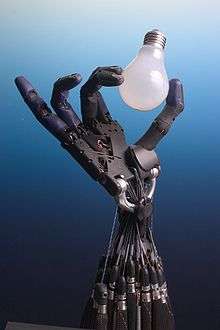Rescue robot
A rescue robot is a robot that has been designed for the purpose of rescuing people.[1] Common situations that employ rescue robots are mining accidents, urban disasters, hostage situations, and explosions. Rescue robots were used in the search for victims and survivors after the September 11 attacks in New York.[2] The benefits of rescue robots to these operations include reduced personnel requirements, reduced fatigue, and access to otherwise unreachable areas.
During September 11 disasters rescue robots were first really tested. They were sent into the rubble to look for survivors and bodies. The robots had trouble working in the rubble of the World Trade Center and were constantly getting stuck or broken. Since then many new ideas have been formed about rescue robots. Engineers and scientists are trying to change the shapes of the robots and take them from wheels to no wheels. “Strong government funding and support is needed if search and rescued robots are to see widespread use in fewer than 14 years.”[3] This means that without the help of government the technology for these devices are not available or they cost too much. These robots are very important in disaster scenarios and are hopefully taking a change for the better.
People like Daniel Goldman, a biophysicist at Georgia Tech, has started building a robot that Piore says “is less like an ATV and more like a sandfish lizard”.[4] Goldman has been spending a lot of time researching and studying the movements of sandfish lizards and trying to develop that into his own robotic idea. Piore states that his robot will be able to “burrow deeper or snake its way back to the surface”.[4] just like a sandfish lizard. This will be helpful in many disaster scenarios. Goldman is trying to develop this robot to be able to maneuver though such terrain as rubble, like in the World Trade Center disaster.
Rescue robots in development are being made with abilities such as searching, reconnaissance and mapping, removing or shoring up rubble, delivery of supplies, medical treatment, and evacuation of casualties. Even with all these ideas coming about there are still some technical challenges that remain. Robin Murphy, a professor of computer science and engineering, says that “Real disasters are infrequent, and every one is different. The robots never get used exactly the way you think they will, and they keep uncovering new bottlenecks and problems. So it’s an emerging technology.”[5]
Murphy states that most rescue robots are not tested in real life situations and more in a situation that the robot can handle. The possible solutions to these problems are what an associate professor of robotics- Howie Choset, is working on. Choset is working on building a “snake robot”. These snake robots are “thin, legless devices with multiple joints”. These snake robots will be used to go places where normal wheeled robots cannot go. The technology still needs some work and the trials they are going through with them aren’t going perfect. Most tests and studies are helping Choset out and are improving these snake robots. “More animal studies would help” says Choset. The robot is based on snakes and their movements, but considering that snakes are made up of 200 bones and the robot is made up of 15 links, there are problems in functionality. There are three main levels of challenges. First, the information processing of the robot. Second, the mobility of the robot. Third, the manipulation of the robot. Bringing these robots into real-world use and being able to utilize them in all situations is so close to becoming a reality. “We're just inches away” Murphy says, “a lot of software is just waiting for the hardware to catch up”.
Fifteen scientists from all over the world were put together on a team of search and rescue professionals from the Federal Emergency Management Agency’s Indiana. They were put together to find problems with rescue robots. Together they put together the R4 program. Which is Rescue Robots for Research and Response. This is a three-year grant and it is there to improve the rescue robot technology and human performance. Three robots were tested during this time and a fourth was introduced to the scientists. Each robot spent about an hour moving around in the rubble and was observed for their movement and how well they were able to make their way through the rubble. They tested the robots on the rubble from the World Trade Center disaster so they could better prepare for a similar disaster. They were looking for two things with these rescue robots. First, how to detect victims and unsafe conditions for rescuers in a highly cluttered, unfavorable environment. Second, how to ensure sensor coverage of a particular volume of space. In one series of tests, robots were put into dark, mine-like conditions. However, the robots were unable to locate half of their targets. Some changes will need to be made if they ever expect these robots to function properly. But once they figure out what they need they will hopefully serve a great purpose and be a greater asset to rescuers.
See also
Further reading
- Robin R. Murphy: Disaster Robotics. MIT Press, Cambridge 2014, ISBN 978-0-262-02735-9.
References
- ↑ Robots to the Rescue St. Petersburg Times Online - Florida
- ↑ In the Aftermath of September 11 What Roboticists Learned from the Search and Rescue Efforts A AAAI press release.
- ↑ Murphy, Robin, “National Science Foundation Summer Field Institute for Rescue Robots for Research And Response (R4)”. Al Magazine 25.2 (2004):133-136. Web. 10 October. 2012
- 1 2 Piore, Adam. “Lesson Learned: A Better Rescue Bot.” Discover 32.8 (2011): 14.Web. 10 October. 2012.
- ↑ Anthes, Gary. “Robots Gear Up for Disaster Response.” Communications of the ACM (2010): 15, 16. Web. 10 Oct. 2012
